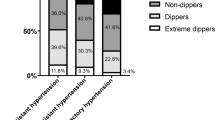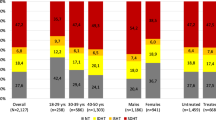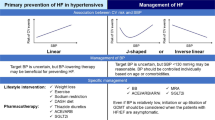Abstract
Cross-sectional surveys on prevalence, treatment and control of hypertension could not satisfactorily distinguish between diastolic hypertension and isolated systolic hypertension because the definition of hypertension included patients under pharmacological treatment. We assessed the situation in the two types of hypertension in general practice in Belgium, based on current blood pressure (BP) measurements and on BP prior to the initiation of drug therapy. Participating physicians enrolled the first 15 at least 55-year-old men visiting the surgery, measured their BP and recorded data on medical history including pretreatment BP, drug utilization, cardiovascular risk factors and target organ damage. Diastolic hypertension was defined as diastolic BP⩾90 mmHg, irrespective of systolic BP, and isolated systolic hypertension as systolic BP⩾140 mmHg and diastolic BP<90 mmHg. Among 3761 evaluable patients, 74% were hypertensive. Among the 1533 hypertensive patients in whom blood pressure was known prior to treatment (n=965) or who were untreated at the study visit (n=568), 1164 had diastolic hypertension and 369 isolated systolic hypertension. The prevalence of antihypertensive treatment was, respectively, 75 and 25% (P<0.001) in these two types of hypertension. The odds of being treated were independently determined by type of hypertension, severity of hypertension and level of risk (P<0.001). BP was controlled in 25% of all patients with diastolic hypertension and in 13% of all patients with isolated systolic hypertension (P<0.001). About half of the treated patients with systolic hypertension were on a diuretic and/or a calcium-channel blocker. In conclusion, isolated systolic hypertension is less frequently treated than diastolic hypertension, overall BP control is poor and actual drug therapy diverges from recommendations based on placebo-controlled intervention trials.
This is a preview of subscription content, access via your institution
Access options
Subscribe to this journal
Receive 12 digital issues and online access to articles
$119.00 per year
only $9.92 per issue
Buy this article
- Purchase on Springer Link
- Instant access to full article PDF
Prices may be subject to local taxes which are calculated during checkout
Similar content being viewed by others
References
Staessen J, Amery A, Fagard R . Editorial review: isolated systolic hypertension in the elderly. J Hypertens 1990; 8: 393–405.
National High Blood Pressure Education Program Working Group. National High Blood Pressure Education Program Working Group Report on Hypertension in the Elderly. Hypertension 1994; 23: 275–285.
Staessen JA et al. Risks of untreated and treated isolated systolic hypertension in the elderly: meta-analysis of outcome trials. Lancet 2000; 355: 865–872.
SHEP Cooperative Research Group . Prevention of stroke by antihypertensive drug treatment in older persons with isolated systolic hypertension: final results of the Systolic Hypertension in the Elderly Program (SHEP). JAMA 1991; 265: 3255–3264.
Staessen JA et al for the Systolic Hypertension in Europe (Syst-Eur) Trial Investigators. Randomised double-blind comparison of placebo and active treatment for older patients with isolated systolic hypertension. Lancet 1997; 350: 757–764.
Liu L et al for the Systolic Hypertension in China (Syst-China) Collaborative Group: comparison of active treatment and placebo for older patients with isolated systolic hypertension. J Hypertens 1998; 16: 1823–1829.
Joint National Committee on Prevention, Detection, Evaluation and Treatment of High Blood Pressure. The Sixth Report of the Joint National Committee on Prevention, Detection, Evaluation and Treatment of High Blood Pressure. Arch Intern Med 1997; 157: 2413–2446.
Guidelines Subcommittee. 1999 World Health Organisation—International Society of Hypertension. Guidelines for the Management of Hypertension. J Hypertens 1999; 17: 151–183.
Burt VL et al. Prevalence of hypertension in the US adult population. Results from the third National Health and Nutrition Examination Survey, 1988–1991. Hypertension 1995; 25: 305–315.
Ibrahim MM et al for the NHP Investigative Team. Hypertension prevalence, awareness, treatment and control in Egypt. Results from the Egyptian National Hypertension Project (NHP). Hypertension 1995; 26 (Part 1): 886–890.
Nieto FJ et al. Population awareness and control of hypertension and hypercholesterolemia. The Atherosclerosis Risk in Communities Study. Arch Intern Med 1995; 155: 677–684.
Mancia G et al. Blood pressure control in the hypertensive population. Lancet 1997; 349: 454–457.
Marques-Vidal P et al. Sex differences in awareness and control of hypertension in France. J Hypertens 1997; 15: 1205–1210.
Banegas JR et al. Blood pressure in Spain. Distribution, awareness, control and benefits of a reduction in average pressure. Hypertension 1998; 32: 998–1002.
Chockalingam A, Fodor JG . Treatment of raised blood pressure in the population. Am J Hypertens 1998; 11: 747–749.
Colhoun HM, Dong W, Poulter NR . Blood pressure screening, management and control in England: results from the health survey for England 1994. J Hypertens 1998; 16: 747–752.
Wolf HK et al. Trends in the prevalence and treatment of hypertension in Halifax Country from 1985 to 1995. Can Med Assoc J 1999; 161: 699–704.
Fagard RH, Pardaens K, Staessen JA . Relationships of heart rate and heart rate variability with conventional and ambulatory blood pressure in the population. J Hypertens 2001; 19: 389–397.
Franklin SS et al. Predominance of isolated systolic hypertension among middle-aged and elderly US hypertensives. Hypertension 2001; 37: 869–874.
Hyman DJ, Pavlik VN . Characteristics of patients with uncontrolled hypertension in the United States. N Engl J Med 2001; 345: 479–486.
Kumpusalo E, Pärnänen H, Takala J . Treatment situation of hypertensive patients in Finnish Primary Health Care. Blood Press 1997; 6 (Suppl 1): 35–39.
Chamontin B et al. Prevalence, treatment and control of hypertension in the French population. Data from a survey on high blood pressure in general practice. Am J Hypertens 1998; 11: 759–762.
Swales JD . Current clinical practice in hypertension: the Eisberg (Evaluation and Intervention for Systolic Blood Pressure Elevation—Regional and Global) project. Am Heart J 1999; 138: S231–S237.
Westheim A et al. Blood pressure levels in treated hypertensive patients in general practice in Norway. Blood Press 2001; 10: 37–42.
EUROASPIRE II Study Group. Lifestyle and risk factor management and use of drug therapies in coronary patients from 15 countries Principal results from EUROASPIRE II Euro Heart Survey Programme. Eur Heart J 2001; 22: 554–572.
Fagard RH, Van den Enden M, Leeman M, Warling X . Survey on treatment of hypertension and implementation of World Health Organization/International Society of Hypertension risk stratification in primary care in Belgium. J Hypertens 2002; 20: 1297–1302.
O'Brien E et al. Blood pressure measuring devices: recommendations of the European Society of Hypertension. BMJ 2001; 322: 531–536.
Fagard RH et al for the Systolic Hypertension in Europe (Syst-Eur) Trial Investigators. Response to antihypertensive therapy in older patients with sustained and nonsustained systolic hypertension. Circulation 2000; 102: 1139–1144.
Staessen J et al. Secondary prevention with beta-blockers in post-myocardial infarction patients. Am Heart J 1982; 104: 1395–1399.
Lechat P et al. Clinical effects of beta-adrenergic blockade in chronic heart failure. A meta-analysis of double-blind, placebo-controlled, randomized trials. Circulation 1998; 98: 1184–1191.
Flather MD et al for the ACE-Inhibitor Myocardial Infarction Collaborative Group. Long-term ACE-inhibitor therapy in patients with heart failure or left ventricular dysfunction: a systematic overview of data from individual patients. Lancet 2000; 355: 1575–1581.
The Heart Outcomes Prevention Evaluation Study Investigators. Effects of an angiotensin-converting-enzyme inhibitor ramipril on cardiovascular events in high-risk patients. N Engl J Med 2000; 342: 145–153.
Marques-Vidal P, Tuomilehto J . Hypertension awareness treatment and control in the community: is the “rule of halves” still valid? J Hum Hypertens 1997; 11: 213–220.
Acknowledgements
We gratefully acknowledge the secretarial assistance of N Ausseloos and the dedicated collaboration of the many general practitioners. The study was supported by a grant from Pfizer, Belgium. RHF is holder of the Professor A Amery Chair in Hypertension Research.
Author information
Authors and Affiliations
Corresponding author
Rights and permissions
About this article
Cite this article
Fagard, R., Van den Enden, M. Treatment and blood pressure control in isolated systolic hypertension vs diastolic hypertension in primary care. J Hum Hypertens 17, 681–687 (2003). https://doi.org/10.1038/sj.jhh.1001598
Received:
Revised:
Accepted:
Published:
Issue Date:
DOI: https://doi.org/10.1038/sj.jhh.1001598
Keywords
This article is cited by
-
Lack of adherence to hypertension treatment guidelines among GPs in southern Sweden-A case report-based survey
BMC Family Practice (2012)
-
Global Cardiovascular Risk Associated With Hypertension and Extent of Treatment and Control According to Risk Group
American Journal of Hypertension (2012)
-
Aim, design and methods of the ‘reasons for not intensifying antihypertensive treatment’ (RIAT): an international registry in essential hypertension
Journal of Human Hypertension (2006)
-
Detection and treatment of hypertension in general health-care practice: a patient-based study
Journal of Human Hypertension (2005)



